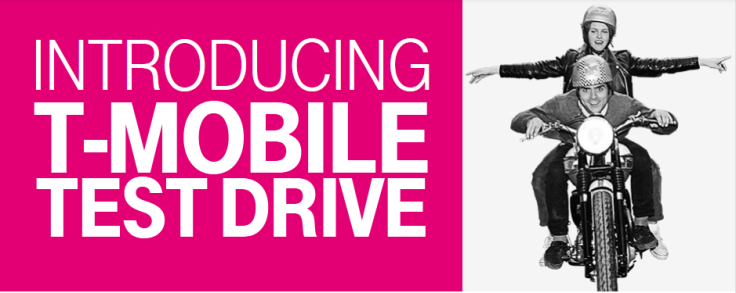Mobile Networks Respond To T-Mobile’s Test Drive

T-Mobile US, Inc.’s (NYSE: TMUS) new Test Drive service, which lets customers try out the iPhone 5s on the carrier’s network free for seven days, has gotten plenty of attention, not only from prospective customers but also from rival mobile networks.
Test Drive is the fifth service released under T-Mobile’s Un-carrier initiative, which was established in early 2013. Following the launch of most of T-Mobile’s new programs, other mobile networks including Sprint Co. (NYSE: S), Verizon Communications (NYSE: VZ) and AT&T Inc. (NYSE: T) have released similar services.
“It’s a competitive response. It shows how competitive the market is and if [a network] introduces a new offer the rivals are taking it seriously,” Roger Entner of Recon Analytics told the International Business Times.
Sprint and Verizon both implemented programs in response to T-Mobile’s Test Drive, which has been available since June 23. Sprint reinstated a 30-day satisfaction guarantee for its devices on the same day that Test Drive became available. The guarantee was discontinued in 2011, according to Fierce Wireless.
Entner told IBTimes that he was very surprised that Sprint had previously cancelled its 30-day satisfaction guarantee.
“That is one of the corner pieces we’ve had in the U.S. -- that we could test [mobile] services for between two to four weeks without risk,” he said.
Sprint’s new-and-improved satisfaction guarantee allows customers to get a full refund of a purchased device in addition to all services and activation chargers accrued if they are not satisfied with the network’s service.
Verizon had also been testing out a “Take Me Home” service in Midwest states such as Kansas and Missouri over the past year, Fierce Wireless recently confirmed. Similar to T-Mobile’s Test Drive, the service allowed prospective customers to test a smartphone or data device like a mobile hotspot on Verizon’s network free for one week.
Smartphones such as the Samsung Galaxy S3 and various BlackBerry (NASDAQ:BBRY) handsets were available under the service; however, the network has reportedly since stopped offering smartphones under the service and now only offers data devices. Verizon spokeswoman Laura Merritt told Fierce Wireless that Take Me Home was not an advertised, nationwide initiative, but rather a service launched to address the specific needs of customers in the Midwest.
Other carriers have quickly responded to a number of T-Mobile’s new services over the past year, such as the Simple Choice Plan, which led the change in the Magenta network’s overall change to its business structure. The Simple Choice Plan got rid of the standard two-year contract structure used by most U.S. mobile networks in favor of an Equipment Installment Plan (EIP) and cheaper services rates. Many rival carriers have responded by establishing their own payment plan options in addition to having a two-year contract option; AT&T has the Next Program, Verizon has the Edge Program and Sprint has the Easy Pay Program.
Carriers have also implemented similar programs to T-Mobile’s Jump Program, which gives customers the option of upgrading to a new smartphone more frequently than every two years and to its program that offers to pay early-termination fees for customers switching over from AT&T, Sprint or Verizon.
During the June 18 press announcement for Test Drive, T-Mobile CEO John Legere said that the carrier has gained more than 17 million customers since the beginning of its Un-carrier initiative.
“What T-Mobile has done is much more a test of confidence in [its] network, which is a good thing,” Entner said. “T-Mobile has improved [its] network to one of the best when in the past it was possibly the worst network and they want people to try it and see for themselves.”
Thus far, Test Drive appears to be getting a mixed reaction. T-Mobile announced that over 12,000 prospective customers preregistered for Test Drive prior to its availability. Several well-known techheads have also tried the service; some with positive previews while others have reported inconsistencies in T-Mobile’s wireless coverage, especially in rural areas, which is a common criticism of the carrier.
T-Mobile spokesperson Lindsay Morio told International Business Times via email Thursday that the carrier is currently in the process of upgrading and expanding its 2G/EDGE network to cover 4G LTE, which it plans to have at least 50 percent completed by the end of the year.
“By the end of 2014, T-Mobile expects to cover around 250 million people with 4G LTE,” Morio said, adding that the carrier plans to have the upgrade completed by mid-2015.
Entner notes that competition between mobile carriers is at its fiercest point now since most people who want to have a cellphone already have one. He told IBTimes that approximately 85 million people are switching from one U.S. mobile network to another each year.
“On average if you’re service is good you’re telling three people and if you have bad service you’re telling seven people,” he added. “It’s in the best interest [of networks] to have happy customers because word of mouth has so much weight.”
This story was updated in order to include a statement from T-Mobile. A previous version of this story was published prior to T-Mobile responding to IBTimes inquiry about its mobile coverage.
© Copyright IBTimes 2024. All rights reserved.












